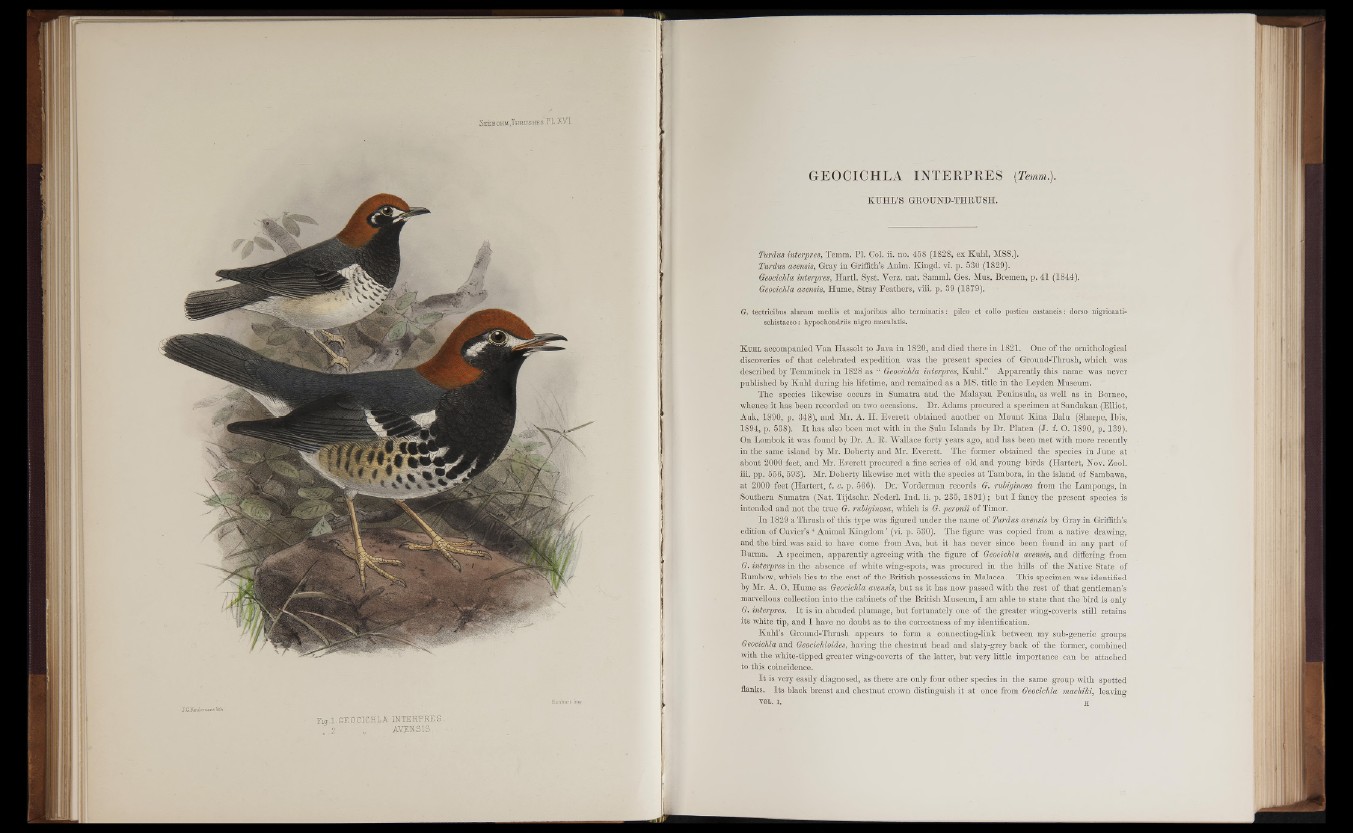
J.GvKe-ulemaixs Tith.
Tig.l.GE0 CICHLA IN’IEEPKES
„ .2 . AVEHSIS.
Hanhart imp..
KUHL'S GEOTJNX)-THB,TJSH.
Turdus interpres, Temm. PI. Col. ii. no. 458 (1828, ex Kuhl, MSS.).
Turdus avensis, Gray in Griffith’s Anim. Kingd. yi. p. 580 (1829).
Geocichla interpres, Hartl. Syst. Yerz. nat. Samml. Ges. Mus. Bremen, p. 41 (1844).
Geocichla avensis, Hume, Stray Feathers, viii. p. 39 (1879).
G. tectricibus alarum mediis et majoribus albo terminatis: pileo et collo postico castaneis: dorso nigrieanti-
scbistaceo: hypocbondriis nigro maculatis.
Kuhl accompanied Yan Hasselt to Java in 1820, and died there in 1821. One of the ornithological
discoveries of that celebrated expedition was the present species of Ground-Thrush, which was
described by Temminck in 1828 as “ Geocichla interpres, Kuhl.” Apparently this name was never
published by Kuhl during his lifetime, and remained as a MS. title in the Leyden Museum.
The species likewise occurs in Sumatra and the Malayan Peninsula, as well as in Borneo,
whence it has been recorded on two occasions. Dr. Adams procured a specimen atSandakan (Elliot,
Auk, 1890, p. 348), and Mr. A. H. Everett obtained another on Mount Kina Balu (Sharpe, Ibis,
1894, p. 538). It has also been met with in the Sulu Islands by Dr. Platen (J. f. O. 1890, p. 139).
On Lombok it was found by Dr. A. R. Wallace forty years ago, and has been met with more recently
in the same island by Mr. Doherty and Mr. Everett. The former obtained the species in June at
about 2000 feet, and Mr. Everett procured a fine series of old and young birds (Hartert, Nov. Zool.
iii. pp. 556, 593). Mr. Doherty likewise met with the species at Tambora, in the island of Sambawa,
at 2000 feet (Hartert, t. c. p. 566). Dr." Vorderman records G. rubiginosa from the Lampongs, in
Southern Sumatra (Nat. Tijdschr. Nederl. Ind. li. p. 235, 1891) ; but I fancy the present species is
intended and not the true G. rubiginosa, which is G. peronii of Timor. ,
In 1829 a Thrush of this type was figured under the name of Turdus avensis by Gray in Griffith’s
edition of Cuvier’s ‘ Animal Kingdom’ (vi. p. 530). The figure was copied from a native drawing,
and the bird was said to have come from Ava, but it has never since been found in any part of
Burma. A specimen, apparently agreeing with , the figure of Geocichla avensis, and differing from
G. interpres in the absence .of white wing-spots, was procured in the hills of the Native State of
Rumbow, which lies to the east of the British possessions in Malacca. This specimen, was identified
by Mr. A. O. Hume as Geocichla avensis, but as it has now passed with the rest of that gentleman’s
marvellous collection into the cabinets of the British Museum, I am able to state that the bird is only
G. interpres. It is in abraded plumage, but fortunately one of the greater wing-coverts still retains
its white tip, and I have no doubt as to the correctness of my identification.
Kuhl’s Ground-Thrush appears to form a connecting-link between my sub-generic groups
Geocichla and Geocichloides, having the chestnut head and slaty-grey back of the former, combined
with the white-tipped greater wing-coverts of the latter, but very little importance can be attached
to this coincidence.
It is very easily diagnosed, as there are only four other species in the same group with spotted
flanks. Its black breast and chestnut crown distinguish it at once from Geocichla machiJd, leaving
y o l . i . H